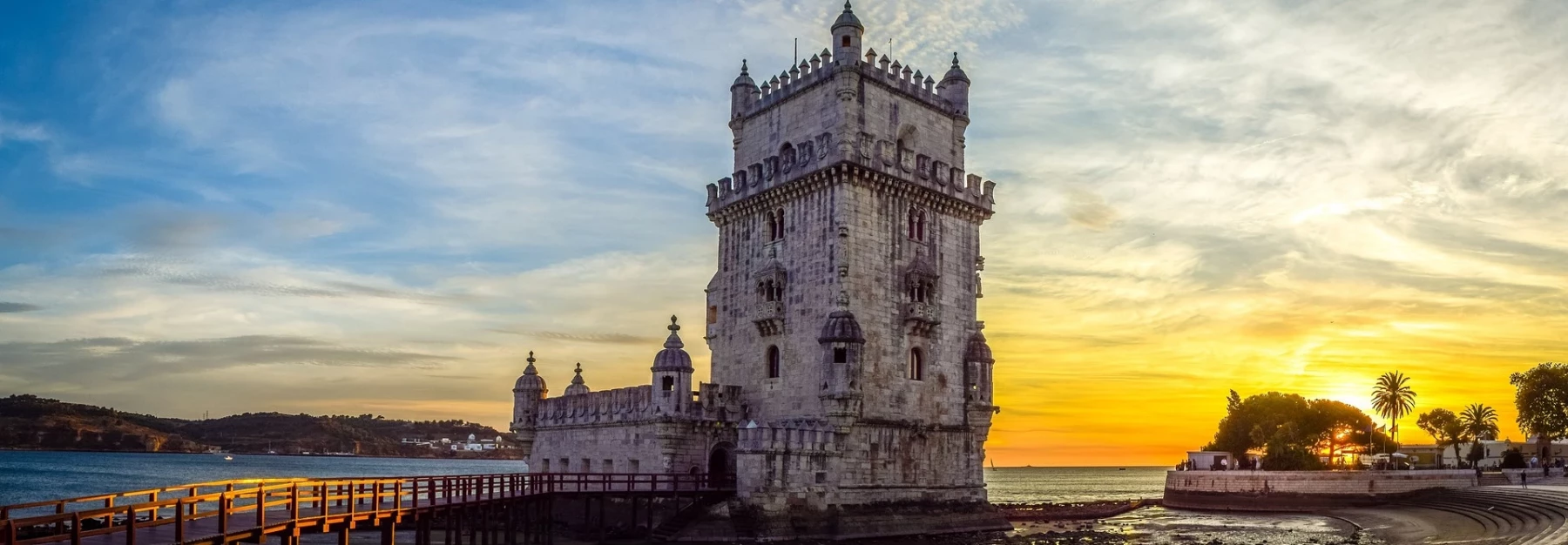To visit - Lisbon
Lisbonne, the capital city of Portugal, is a captivating blend of history, culture, and modern vibrancy. Perched along the banks of the Tagus River, Lisbon's hills are adorned with colorful buildings and historic landmarks. The Alfama district, with its narrow cobblestone streets, exudes an old-world charm, inviting visitors to explore its historic alleys and catch glimpses of traditional Fado performances in intimate venues.
The iconic Belém Tower, a symbol of Portugal's Age of Discovery, stands proudly near the river, while the Jerónimos Monastery showcases stunning Manueline architecture. Lisbon's hills are conquered by historic tram rides, offering panoramic views of the city. Bairro Alto comes alive at night with its lively atmosphere, offering an array of bars, restaurants, and Fado houses.
Lisbon embraces both tradition and modernity, with the historic São Jorge Castle overseeing the city and the contemporary MAAT (Museum of Art, Architecture and Technology) adding a modern architectural flair. The LX Factory, a former industrial complex turned creative hub, is a testament to Lisbon's dynamic arts scene.
The city's cuisine is a treat for the senses, with local delicacies like pastéis de nata (custard tarts) and bacalhau (salted cod) enticing food enthusiasts. Lisbon's welcoming spirit, coupled with its historical treasures and cultural richness, makes it a must-visit destination for those seeking an immersive and diverse travel experience.
The 14 essential things to do in Lisbon :
Summary
- To visit
-
- 1 - Explore the Alfama District
- 2 - Explore Belém Tower
- 3 - The Jerónimos Monastery
- 4 - Stroll the bustling streets of Bairro Alto
- 5 - Admire the grandeur of Commerce Square (Terreiro do Paço)
- 6 - Ride the Santa Justa Elevator
- 7 - Visit the Château Saint-Georges
- 8 - Visit the National Azulejo Museum
- 9 - The National Pantheon
- 10 - Take Tram 28
- 11 - Take a Cruise on the Tagus River
- 12 - Attend a Fado Show
- 13 - Taste Pastéis de Nata
- 14 - Take a trip to Cascais
- Lisbon - Where to Stay?
- Lisbon - How to get around?
- Lisbon - Best period
1 - Explore the Alfama District
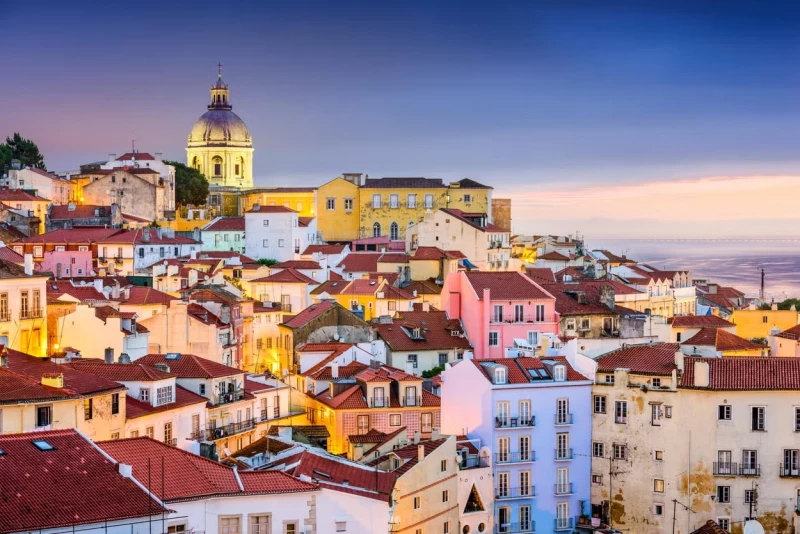
The Alfama District is one of the oldest and most picturesque neighborhoods in Lisbon, Portugal. It offers an authentic experience with its narrow streets, colorful houses, winding staircases, and stunning views of the city. Here are some suggestions for exploring this fascinating quarter:
-
São Jorge Castle: Start your visit at São Jorge Castle, which provides panoramic views of Lisbon. Explore the ramparts, gardens, and learn about the city's history.
-
Miradouros: Alfama is dotted with miradouros, or viewpoints, offering magnificent panoramas of the city. Don't miss Miradouro das Portas do Sol and Miradouro da Graça for spectacular views.
-
Sé de Lisboa: Visit Lisbon Cathedral, also known as Sé de Lisboa, one of the oldest churches in the city. It is located in the heart of Alfama.
-
Stroll through the alleyways: Get lost in Alfama's narrow streets. Discover houses adorned with colorful azulejos, charming little squares, and immerse yourself in the authentic atmosphere of the neighborhood.
-
Fado: Alfama is the birthplace of fado, a Portuguese music genre with a melancholic tone. Many bars and restaurants in the area offer fado performances in the evening—an essential experience to grasp the local culture.
-
Museums and art galleries: Explore the museums and art galleries scattered throughout the neighborhood. The Fado Museum and the Museum of Design and Fashion are interesting options.
-
Feira da Ladra: If you're in Alfama on a Tuesday or Saturday, don't miss the Feira da Ladra flea market. You'll find antiques, vintage clothing, and a variety of unique items.
-
Local cuisine: Taste local cuisine at one of the many small restaurants in Alfama. Try traditional Portuguese dishes such as bacalhau (cod), grilled sardines, and pastéis de nata.
By exploring the Alfama District, you'll dive into the history, culture, and unique atmosphere of Lisbon. Enjoy every corner to discover something new.
 Our tips for getting the most out of your experience.
Our tips for getting the most out of your experience.
Exploring the Alfama District in Lisbon can be a rewarding experience. Here are some tips to make your exploration more enjoyable and immersive:
-
Comfortable Shoes: The cobblestone streets of Alfama can be uneven, so wear comfortable shoes for easy walking through the neighborhood.
-
Offline Map: Download an offline map of the area on your phone to avoid getting lost in the narrow streets.
-
Explore on Foot: Alfama is best explored on foot. Get lost in the winding streets and discover hidden corners that you might miss when using public transportation.
-
Visit Early Morning or Evening: To avoid intense heat, visit Alfama early in the morning or in the evening. This also allows you to enjoy the romantic atmosphere when the lights come on in the alleys.
-
Be Open to Discovery: Allow yourself to be surprised by small shops, street artists, and spontaneous events. Alfama is full of hidden treasures.
-
Attend a Fado Show: For an authentic experience, attend a Fado show in one of the small bars in the neighborhood. It's a unique opportunity to experience traditional Portuguese music.
-
Enjoy Miradouros: Don't miss the viewpoints (miradouros) for exceptional panoramas of the city. Bring your camera to capture breathtaking views.
-
Taste Local Specialties: Sample local cuisine in Alfama's small restaurants and taverns. Try traditional dishes such as cod, grilled sardines, and sweets like pastéis de nata.
-
Avoid Tourist Peak Hours: Alfama is popular among tourists. If possible, avoid peak hours to enjoy a quieter and more intimate atmosphere.
-
Respect Locals: Alfama is also a residential area. Be respectful towards the locals, avoid making too much noise, and respect their privacy.
By following these tips, you'll be better prepared to explore and fully appreciate the unique charm of the Alfama District in Lisbon.
2 - Explore Belém Tower
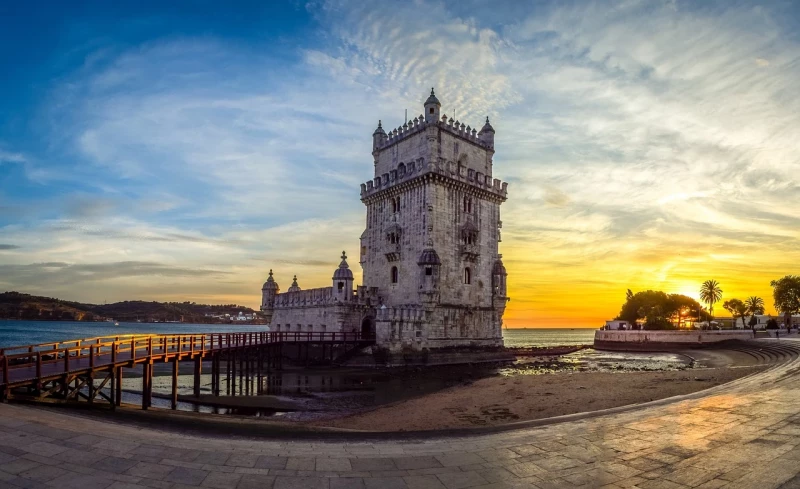
The Belém Tower, constructed between 1514 and 1520 along the majestic banks of the Tagus River in Lisbon, epitomizes the essence of Manueline architecture. This iconic structure, a UNESCO World Heritage Site, was initially built for defensive purposes, safeguarding the entrance to the port of Lisbon. Adorned with intricate details, including maritime motifs, ropes, and seashells, the tower provides a unique fusion of functionality and artistic beauty. Exploring its interior chambers, such as the throne room and chapel, transports visitors to a bygone era of Portuguese history.
Soaring majestically, the tower also offers breathtaking views from its upper levels, showcasing panoramas of the river and the city. The surrounding gardens enhance the experience, inviting relaxation and contemplation. Nearby lies the renowned Belém pastry shop, where visitors can savor the delightful pastéis de nata, a local specialty. Opening hours and admission fees may vary, but purchasing combined tickets for multiple attractions in Belém can be a cost-effective option. With its rich history, distinctive architecture, and picturesque location, the Belém Tower remains a must-visit for anyone exploring the Portuguese capital. Don't forget to bring your camera to capture the timeless grandeur of this architectural gem.
 Our tips for getting the most out of your experience.
Our tips for getting the most out of your experience.
Exploring Belém Tower in Lisbon can be a fascinating experience. Here are some tips to make the most of your visit:
-
Opening Hours: Check the opening hours of Belém Tower before your visit. Hours may vary depending on the season, holidays, or any closures for special events.
-
Combined Tickets: If you plan to visit other attractions in Belém, consider purchasing combined tickets. This can save you time and money.
-
Tour Guides: Hiring a tour guide can enhance your experience by providing detailed historical and cultural information about the tower and its surroundings.
-
Morning Visit: To avoid crowds, consider visiting Belém Tower early in the morning. This allows you to peacefully appreciate the architecture and panoramic views.
-
Audio-Guide App: Some towers offer audio-guide apps. Download the one for Belém Tower to receive detailed information during your visit.
-
Photography: Bring a camera or smartphone with good photo-capturing capabilities. Belém Tower offers excellent photographic opportunities, both from the inside and the surrounding areas.
-
Flow of Traffic: Follow the recommended flow of traffic to avoid congestion on the narrow stairs of the tower, especially during peak hours.
-
Respect Site Rules: Adhere to site rules, such as not touching historical artifacts and following safety guidelines.
-
Binoculars: If you're passionate about architectural details, bring binoculars to get a closer look at the ornamental elements of the tower from elevated vantage points.
-
Plan a Coffee Break: Plan for a coffee break at one of the nearby cafes to relax after touring the tower.
By following these tips, you can optimize your experience when visiting Belém Tower and fully appreciate its history, architecture, and panoramic views.
3 - The Jerónimos Monastery
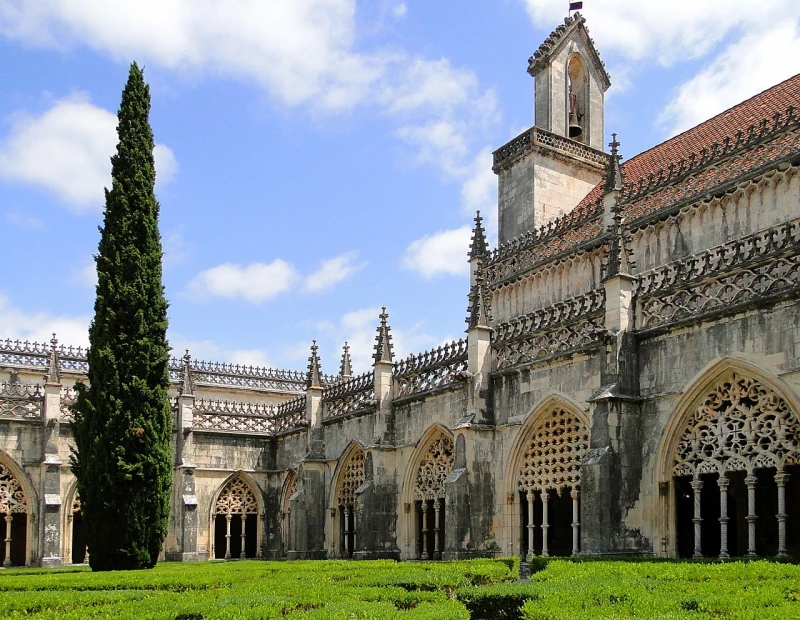
The Jerónimos Monastery, also known as Mosteiro dos Jerónimos, stands majestically in the Belém district of Lisbon, Portugal. Built in the 16th century to commemorate Vasco de Gama's triumphant return from India, this architectural masterpiece embodies the Manueline style, a flamboyant expression of Portuguese Gothic characterized by ornate details and maritime motifs. Visitors are immediately struck by the monastery's elegance, reflected in its exceptional cloister, elaborate vaults, and sculptural details.
Inside the Santa Maria church within the monastery, a sense of reverence permeates the atmosphere. The tombs of historical figures, including Vasco de Gama himself, add a commemorative dimension to the experience. The royal tombs of King Manuel I and Queen Maria I also stand as magnificent testaments to Portuguese royal history.
The cloister, once a place of meditation for monks, captivates with its beauty and refinement. Finely carved arches and architectural details illustrate the creative genius of the time. Visitors can stroll through this space, absorbing the history and art emanating from every stone.
Opening hours vary, so it's advisable to check before planning your visit. If your exploration also takes you to other iconic sites in Belém, such as the Belém Tower, consider combined tickets to maximize your experience.
Whether opting for a guided tour for an in-depth immersion in history or choosing to explore independently, the Jerónimos Monastery offers a captivating dive into Portugal's cultural and religious heritage. Wandering through its corridors and sacred spaces, you'll find yourself enveloped in the grandeur of a monument that transcends the centuries.
 Our tips for getting the most out of your experience.
Our tips for getting the most out of your experience.
Visiting the Jerónimos Monastery (Mosteiro dos Jerónimos) in Lisbon can be a rewarding experience. Here are some tips to make the most of your visit:
-
Opening Hours: Check the monastery's opening hours before planning your visit. Be aware of peak days and times to avoid crowds.
-
Combined Tickets: If you plan to visit other attractions in Belém, such as the Belém Tower, consider purchasing combined tickets to save time and money.
-
Early Morning Visit: To avoid crowds, consider visiting the monastery early in the morning. This allows you to fully enjoy the experience without the congestion of visitors.
-
Audio-Guide App: If available, use an audio-guide app to get detailed information about different points of interest in the monastery while exploring at your own pace.
-
Guided Tour: Opt for a guided tour if you want a thorough understanding of the history, architecture, and details of the monastery. Guides can provide valuable contextual information.
-
Exploration Time: Allocate enough time to explore the monastery without feeling rushed. There are many architectural and historical details to appreciate.
-
Respect Site Rules: Be respectful of the monastery's rules, such as photography restrictions, and avoid touching exhibited objects.
-
Explore the Cloister: Don't miss the magnificent monastery cloister. Explore its finely sculpted arches and tranquil inner gardens.
-
Belém Pastry: Take advantage of your visit to Belém to taste the delicious pastéis de nata at the nearby Belém pastry shop.
-
Enjoy the Surroundings: After touring the monastery, stroll around the Belém area. Visit other local attractions or relax in one of the cafés near the river.
By following these tips, your visit to the Jerónimos Monastery will be more enjoyable and enriching. Enjoy the history, architecture, and cultural beauty of this iconic site
4 - Stroll the bustling streets of Bairro Alto
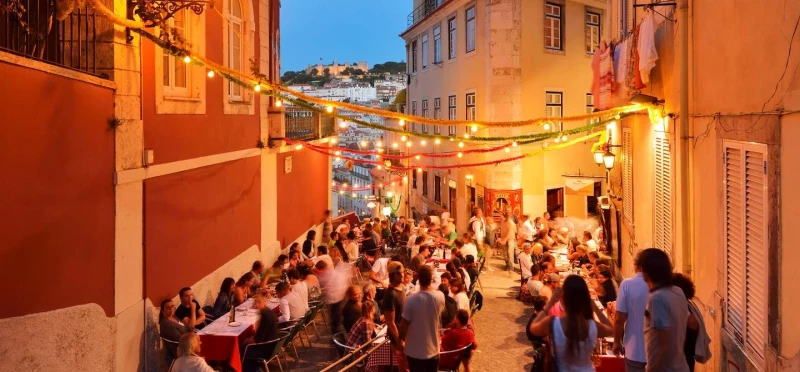
The lively streets of Bairro Alto in Lisbon are a true gem of nightlife, culture, and bohemian atmosphere. Here are some details and tips for exploring this iconic Lisbon neighborhood:
-
Vibrant Nightlife: Bairro Alto is famous for its lively nightlife. The streets come alive, especially in the evening when bars and clubs open their doors. The cobblestone streets resonate with music, laughter, and lively conversations.
-
Traditional Fado: Sip a glass of Portuguese wine in one of Bairro Alto's Fado bars. Fado is an authentic and melancholic Portuguese musical genre that often expresses nostalgia and emotion.
-
Narrow Alleys: Explore the narrow and winding alleys of Bairro Alto. It's in these small streets that you'll discover quaint shops, art galleries, and local restaurants.
-
Miradouros: Don't miss the Miradouros (viewpoints) in Bairro Alto. These spots offer spectacular views of the city, and you might catch a sunset over the rooftops of Lisbon.
-
Street Art: Bairro Alto is known for its alternative art scene. Walls are often adorned with colorful graffiti and street art, adding a bohemian atmosphere to the area.
-
Small Cafés and Restaurants: Stop by one of the many small cafés and restaurants. Taste local cuisine and take the time to savor the laid-back atmosphere of Bairro Alto.
-
Local Shopping: Discover local shops selling handmade products, vintage clothing, and other unique items. It's a great place to find original souvenirs.
-
Be Ready to Walk: Bairro Alto is a neighborhood best explored on foot. The cobblestone streets can be challenging in high heels, so opt for comfortable shoes.
-
Respect Residents: Bairro Alto is also a residential area. Be respectful to the locals and avoid making too much noise, especially late at night.
-
Safety: Like in any lively area, be aware of your belongings and stay attentive to your surroundings, especially at night.
Bairro Alto offers a unique experience where the vibrant energy of the streets blends with Lisbon's rich cultural history. Enjoy every moment in this dynamic neighborhood and let yourself be carried away by its charm.
 Our tips for getting the most out of your experience.
Our tips for getting the most out of your experience.
Strolling through the lively streets of Bairro Alto in Lisbon can be a wonderfully immersive experience. Here are some tips to make the most of your leisurely walk in this bohemian quarter:
-
Slow Exploration: Take your time to intentionally get lost in the winding alleys of Bairro Alto. Some of the most interesting discoveries are often made at the pace of a leisurely stroll.
-
Discover the Miradouros: The Miradouros (viewpoints) in Bairro Alto offer incredible panoramic views of Lisbon. Spot these vantage points and take the time to soak in the scenery.
-
Meet the Locals: Feel free to strike up a conversation with the locals. Lisbonites are often welcoming and might provide insights into lesser-known but equally charming spots.
-
Hidden Bars: Explore less frequented bars and taverns. Some of the best moments in Bairro Alto can be experienced in off-the-beaten-path locations.
-
Nighttime Ambiance: If you're strolling in the evening, be prepared to encounter a unique nighttime atmosphere. The streets come alive with street musicians, artists, and spontaneous performances.
-
Taste Local Flavors: Make a detour to small shops and markets to taste local culinary delights. Pastéis de nata and traditional dishes are worth a sampling.
-
Street Art: Take the time to appreciate street art. Bairro Alto is known for its colorful murals and creative graffiti that add an artistic layer to the neighborhood.
-
Capture the Moment: Bairro Alto is full of photogenic corners. Keep your camera handy to capture the present moment.
-
Avoid Peak Hours: If you prefer a more peaceful experience, avoid peak tourist hours. Bairro Alto reveals its true charm outside of the busiest times.
-
Be Open to the Unexpected: Bairro Alto often holds surprises. Be open to unexpected discoveries, whether it's street performances, small markets, or spontaneous events.
By following these tips, you'll turn your stroll through the lively streets of Bairro Alto into an authentic and memorable adventure. Enjoy every street corner and let yourself be immersed in the unique atmosphere of this Lisbon neighborhood.
5 - Admire the grandeur of Commerce Square (Terreiro do Paço)
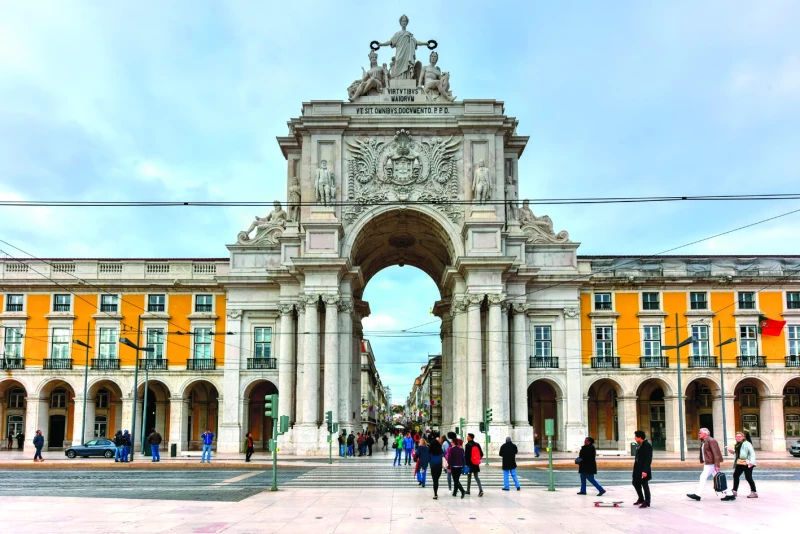
The Commerce Square, also known as Terreiro do Paço, is one of the iconic squares in Lisbon, Portugal. Here is some information and tips for exploring this historic site:
-
History: Commerce Square has a rich history dating back to the 18th century. It was once the site of the Royal Palace before being destroyed by the 1755 earthquake. The square was rebuilt with an elegant design after the catastrophe.
-
Architecture: Admire the imposing architecture that surrounds the square. The pastel-toned buildings, adorned with arches and columns, create a majestic atmosphere.
-
Triumphal Arch: To the north of the square, you'll find the Triumphal Arch, an impressive monument that offers panoramic views of the city from its top.
-
Statue of Joseph I: At the center of the square, sits the equestrian statue of Joseph I, dating back to the 18th century. It adds a historical touch to the ensemble.
-
Stroll along the Tagus River: Commerce Square faces the Tagus River. Enjoy a pleasant stroll along the waterfront, offering beautiful views of the river and the 25th of April Bridge.
-
Café Terraces: The café terraces lining the square are perfect places to enjoy Portuguese coffee and observe the lively local life.
-
Events and Manifestations: Commerce Square often hosts cultural events, concerts, and manifestations. Check if there are any special activities during your visit.
-
Access: The square is easily accessible on foot from various downtown neighborhoods. It is also served by public transportation, including trams and the metro.
-
Shops and Restaurants: Explore the shops and restaurants surrounding the square. Some offer Portuguese handmade products and local cuisine.
-
Night Lighting: Commerce Square takes on a magical atmosphere in the evening with its lighting. It's an ideal spot for a nighttime stroll.
By visiting Commerce Square, you'll have the opportunity to immerse yourself in the history and beauty of Lisbon while enjoying a dynamic and picturesque atmosphere.
 Our tips for getting the most out of your experience.
Our tips for getting the most out of your experience.
Exploring Commerce Square (Terreiro do Paço) in Lisbon can be a captivating experience. Here are some tips to make the most of your visit:
-
Ideal Timing: Visit the square at different times of the day to appreciate variations in light. The morning offers a quieter atmosphere, while the afternoon can be livelier.
-
Riverside Stroll: Take advantage of the proximity to the Tagus River by strolling along the quays from Commerce Square. It's a beautiful walk with breathtaking views.
-
Climb the Triumphal Arch: If weather permits, climb to the top of the Triumphal Arch for an exceptional panoramic view of the city and the river.
-
Relax at a Terrace: Choose one of the café terraces to relax, enjoy a Portuguese coffee, and observe local life while admiring the majestic architecture.
-
Special Events: Check the local schedule to see if there are special events or festivals taking place on the square during your visit.
-
Explore the Surroundings: Explore the surrounding areas, especially the Baixa district, with its shops, restaurants, and pedestrian streets.
-
Tage River Cruise: If weather permits, consider taking a short cruise on the Tagus River to see Lisbon from a different perspective.
-
Evening Visit: The square takes on a special atmosphere in the evening with its lighting. It's an ideal spot for a romantic stroll after sunset.
-
Use Public Transportation: The square is well-connected by public transportation, such as trams and the metro. Use them to move easily around the city.
-
Capture the Moment: Bring a camera to capture special moments and the unique architectural details of the square.
By following these tips, you can fully appreciate the beauty, history, and vibrant atmosphere of Commerce Square in Lisbon. Enjoy every moment of your visit to this iconic location.
6 - Ride the Santa Justa Elevator
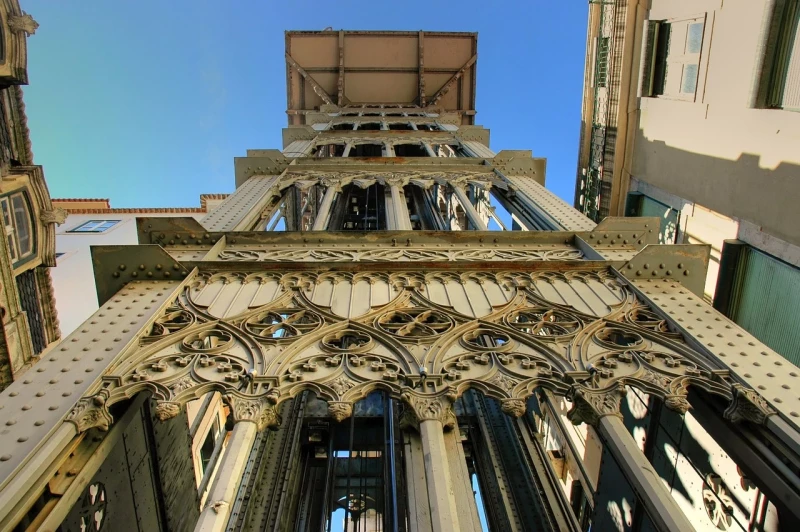
The Santa Justa Elevator, inaugurated in 1902 in Lisbon, is more than just a vertical transportation device. Designed by Portuguese engineer Raoul Mesnier du Ponsard, this elegant elevator is a remarkable architectural masterpiece, characterized by its distinctive neogothic style. The intricate wrought-iron details and metal structure give the elevator a unique aesthetic, marking it as one of the city's iconic landmarks.
Beyond its primary function of transporting passengers between the districts of Baixa and Bairro Alto, the Santa Justa Elevator offers an unparalleled panoramic experience. Taking the elevator to the observation platform at the top rewards visitors with breathtaking views of Lisbon. The São Jorge Castle, the rooftops of Baixa, and the majestic Tagus River unfold before them, creating a memorable tableau.
To maximize the experience, it is advisable to visit the Santa Justa Elevator early in the morning or late in the afternoon to avoid crowds. Visitors can also enjoy the Café de Santa Justa on the platform, providing a pleasant setting to savor a drink while contemplating the view.
Beyond its functional role, the elevator sometimes becomes the stage for special events, adding an artistic dimension to its allure. Occasional concerts and exhibitions can occur, infusing a cultural touch into this already history-rich structure.
Accessible from Baixa, near Rossio Square, the Santa Justa Elevator is not just a means of efficiently moving around the city but also an immersive experience in Lisbon's architecture and panoramas. Whether you're a history buff, art enthusiast, or someone who appreciates panoramic views, this elevator offers a comprehensive experience that unveils the splendor of the Portuguese capital.
 Our tips for getting the most out of your experience.
Our tips for getting the most out of your experience.
Boarding the Santa Justa Elevator in Lisbon can be a unique experience. Here are some tips to make the most of it:
-
Choose the Right Time: Avoid peak tourist hours for a more enjoyable experience. Early morning or late afternoon is often less crowded.
-
Combined Ticket: If you plan to visit other tourist attractions in Lisbon, consider purchasing a combined ticket to save on entrance fees.
-
Prefer Electronic Payments: If possible, use electronic payment methods to buy your tickets and avoid waiting in line at the ticket counters.
-
Opt for the Observation Deck: Don't forget to ascend to the observation deck at the top. The panoramic view of Lisbon is well worth it.
-
Capture the Sunset: If you have the opportunity to visit the elevator in the late afternoon, it can be an ideal time to capture the sunset over the city.
-
Relax at Café de Santa Justa: Take the time to relax at Café de Santa Justa on the platform. It's a pleasant spot to enjoy a beverage while taking in the view.
-
Be Prepared for Wait Times: Even during less busy hours, there might be a wait. Be prepared to wait a bit, especially if you plan to take the elevator at a popular time.
-
Listen to Audio Commentaries: If audio commentaries are available during your ascent, use them to learn more about the history and architecture of the elevator and its surroundings.
-
Check for Special Events: See if there are any special events or temporary exhibitions scheduled during your visit.
-
Stay Informed about Weather: If possible, choose a clear day to ensure maximum visibility from the observation deck.
By following these tips, boarding the Santa Justa Elevator will be a pleasant and enriching experience, offering an exceptional panoramic view of the beautiful city of Lisbon.
7 - Visit the Château Saint-Georges
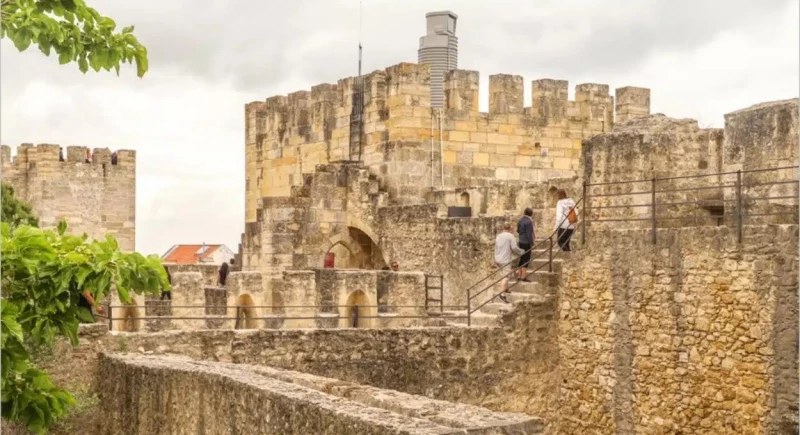
Perched majestically atop a hill in the heart of Lisbon, the São Jorge Castle stands as a centerpiece of the city's history. Built in the 11th century by the Moors, the castle played a strategic role in the defense of the city. Its imposing architecture, marked by sturdy walls and soaring towers, bears witness to its medieval and Moorish past.
Once inside, visitors are greeted with breathtaking panoramic views. The ramparts provide a stunning spectacle of the city center, the Tagus River, and the characteristic rooftops of Lisbon. It serves as a privileged vantage point that transports visitors through the centuries, evoking the city's tumultuous history.
The lush gardens within the walls create a soothing contrast to the castle's imposing appearance. Well-maintained green spaces offer shaded areas for relaxation, creating a tranquil atmosphere amidst the hustle and bustle of the city.
The São Jorge Castle extends beyond its impressive architecture. Exhibitions and cultural events are often hosted, providing visitors with a deeper immersion into Lisbon's history and culture. Guided tours or the use of audio guides can further enhance the experience by providing historical and architectural details.
To avoid crowds, it is recommended to visit the castle early in the morning or late in the afternoon. This privileged time also allows visitors to appreciate the enchanting spectacle of the sunset from the castle's heights.
The Porta de Almada, the main entrance to the castle, is a true work of art adorned with Moorish and medieval symbols. Passing through this historic gate adds a symbolic dimension to the visit, reinforcing the connection with the São Jorge Castle's rich past.
Exploring this iconic site goes beyond a mere tourist visit; it is a dive into the historical soul of Lisbon, a living testament to its glorious past that enchants and fascinates visitors from around the world.
 Our tips for getting the most out of your experience.
Our tips for getting the most out of your experience.
Visiting São Jorge Castle in Lisbon is a fascinating experience. Here are some tips to make your visit even more enriching:
-
Arrive Early: To avoid crowds, arrive at the castle right when it opens. This allows you to fully enjoy the peaceful atmosphere of the site.
-
Combined Ticket: If you plan to visit other attractions in Lisbon, consider purchasing a combined ticket to save on entrance fees.
-
Take a Guided Tour: Opt for a guided tour to gain in-depth insights into the castle's history, architecture, and the events that unfolded within its walls.
-
Explore Temporary Exhibitions: Check for any temporary exhibitions happening within the castle. This can add a cultural dimension to your visit.
-
Take Less Traveled Paths: Explore less-visited corners of the castle for a more authentic experience. The ramparts often offer spectacular views away from the crowds.
-
Allocate Time for Gardens: The gardens inside the castle provide a tranquil space. Allocate time to relax, take photos, and enjoy the ambiance.
-
Check the Weather: Before your visit, check the weather. A sunny day can enhance the spectacular views from the castle.
-
Attend Special Events: If special events or historical reenactments are scheduled, try to include them in your visit for an immersive experience.
-
Wear Comfortable Shoes: The castle pathways can be paved and sometimes uneven. Comfortable shoes are essential for hassle-free exploration.
-
Bring Water and Snacks: Exploring the castle can take time, so make sure to have water and some snacks to stay energized.
By following these tips, you'll maximize your visit to São Jorge Castle, delving into Lisbon's captivating history while appreciating the exceptional panoramic views from this iconic site.
8 - Visit the National Azulejo Museum

The National Tile Museum, housed in the splendid Convento da Madre de Deus in Lisbon, celebrates the traditional Portuguese art of azulejos. The historical 16th-century convent, serving as the museum's backdrop, is already a remarkable architectural masterpiece adorned with decorative azulejos that add an artistic dimension to the surroundings.
The museum's permanent collection takes visitors on a chronological journey through the evolution of azulejos, showcasing pieces ranging from religious scenes to intricate artistic representations. Exploring these works unveils the skill and creativity of Portuguese artisans over the centuries.
The convent's gardens provide a serene setting, where visitors can stroll among outdoor azulejos, creating an immersive experience. The museum also offers workshops and demonstrations, allowing visitors to grasp the traditional techniques of azulejo craftsmanship.
Beyond the permanent collection, temporary exhibitions spotlight contemporary artists, injecting a modern touch into this ancient art. The museum's shop offers unique souvenirs, while special events and lectures enhance the cultural experience.
Whether one appreciates azulejos for their narrative character or visual aesthetics, the National Tile Museum stands as a must-visit for art enthusiasts and curious minds eager to delve into Portugal's rich artistic history. With online ticket options available, it provides an accessible immersion into this unique cultural heritage.
 Our tips for getting the most out of your experience.
Our tips for getting the most out of your experience.
Visiting the National Tile Museum in Lisbon can be a rich experience filled with artistic and historical discoveries. Here are some tips to enhance your visit:
-
Online Tickets: Purchase your tickets online in advance to avoid queues at the museum entrance.
-
Guided Tour: Opt for a guided tour to gain in-depth insights into the exhibited works and the history of azulejos. Some guides may offer unique perspectives.
-
Explore the Gardens: Take the time to explore the convent gardens surrounding the museum. It's a peaceful place to appreciate outdoor azulejos and relax.
-
Workshops and Demonstrations: If workshops or demonstrations are offered, participate to get an insight into the traditional manufacturing process of azulejos.
-
Temporary Exhibition Calendar: Check the calendar for temporary exhibitions to see if contemporary artists are showcasing their works at the museum.
-
Photograph Respectfully: Take photos, but be sure to respect the museum's rules. Some areas may have photographic restrictions.
-
Historical Background: Learn about the history of azulejos before your visit to better understand the themes and techniques presented in the artworks.
-
Museum Shop: Visit the museum shop to purchase unique souvenirs such as azulejo reproductions or books on the art of azulejos.
-
Respect Craftsmanship: Appreciate the craftsmanship behind each azulejo. This can add a new dimension to your experience.
-
Check for Special Events: See if there are special events, lectures, or artist meet-ups scheduled during your visit.
By following these tips, your visit to the National Tile Museum will not only be informative but also a comprehensive immersion into the art and history of Portuguese azulejos. Enjoy every moment spent exploring this unique cultural heritage.
9 - The National Pantheon
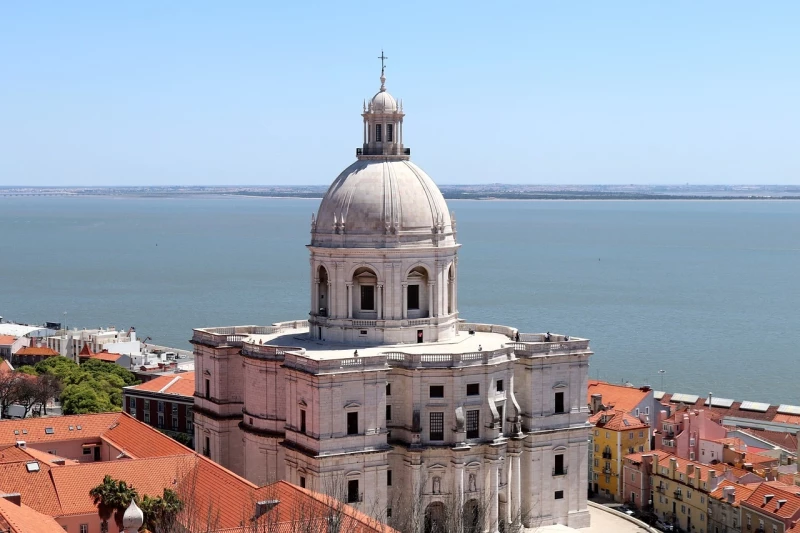
The National Pantheon (Panteão Nacional) in Lisbon is an imposing monument steeped in history. Here is some information and tips for exploring this iconic edifice:
-
History: The National Pantheon is housed in the former Santa Engrácia Church. Construction of the church began in the 17th century, but it was only completed in the 20th century, giving it a unique character.
-
Architecture: The architecture of the Pantheon is remarkable, featuring an imposing dome. The dome offers panoramic views of the city, and the interior showcases both Baroque and Neoclassical elements.
-
Buried Personalities: The Pantheon is the final resting place for numerous prominent Portuguese figures, including writers, artists, and other historical figures such as Amália Rodrigues, the renowned fado singer.
-
Panoramic View: Climb to the top of the dome to enjoy an impressive panoramic view of Lisbon. It is one of the best vantage points to appreciate the city's architecture.
-
Temporary Exhibitions: Check if there are any temporary exhibitions taking place during your visit. These exhibitions can provide additional insights into Portuguese history and culture.
A visit to the National Pantheon offers a dive into Portugal's history while allowing you to admire spectacular architecture and pay homage to the memory of individuals who have left a lasting impact on the country.
 Our tips for getting the most out of your experience.
Our tips for getting the most out of your experience.
Visiting the National Pantheon in Lisbon is a fascinating experience, steeped in history and architectural grandeur. Here are some tips to make the most of your visit:
-
Online Tickets: Purchase your tickets online in advance to avoid queues at the entrance of the Pantheon.
-
Early Morning Visit: For a more peaceful experience, consider visiting early in the morning when the site is less crowded.
-
Climb the Dome: Don't miss the opportunity to climb to the dome of the Pantheon for a breathtaking panoramic view of Lisbon. It's one of the highlights of the visit.
-
Explore the Interior: Take the time to explore the interior of the Pantheon, where the tombs of illustrious Portuguese figures add a historical dimension to the grand architecture.
-
Check the Event Calendar: See if there are any special events, concerts, or temporary exhibitions scheduled during your visit.
-
Souvenir Shop: Take a stroll through the souvenir shop to purchase unique mementos related to the history and architecture of the Pantheon.
-
Learn the History: Before visiting, familiarize yourself with the history of the Pantheon to better appreciate the symbols and architectural details.
-
Guided Tours: If possible, join a guided tour to gain in-depth insights into the monument and its cultural significance.
-
Respect Silence: As a place of burial, maintain a respectful tone and observe silence in dedicated areas.
-
Avoid Holidays: If possible, avoid public holidays or peak days for a quieter experience.
By following these tips, your visit to the National Pantheon will be an enriching immersion into Portugal's history and the architectural splendor of Lisbon. Enjoy every moment in this solemn and culturally significant site.
10 - Take Tram 28
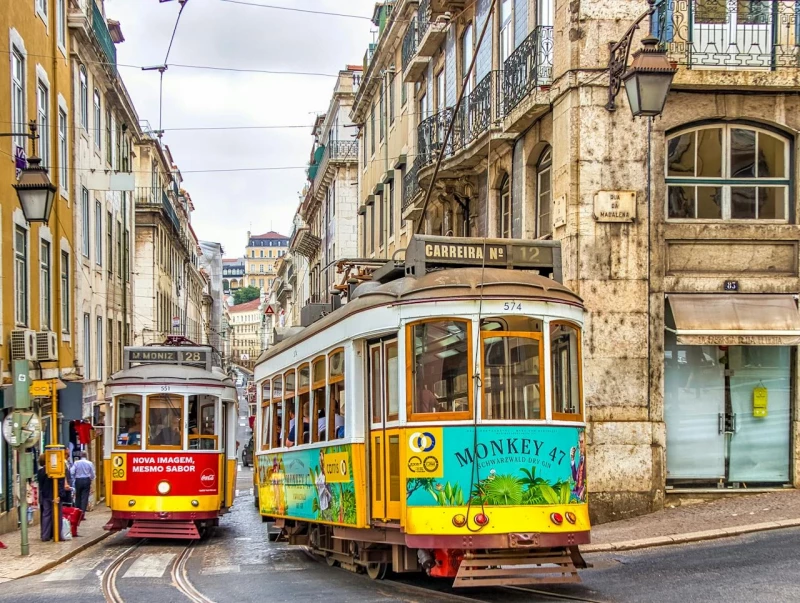
Tram 28 in Lisbon is an iconic and popular tram route that takes you on a picturesque journey through some of the city's most historic neighborhoods. Here are some key details and tips for experiencing Tram 28:
-
Scenic Route: Tram 28 follows a scenic route through various iconic neighborhoods, including Graça, Alfama, Baixa, and Campo de Ourique. It provides an excellent way to explore the diversity of Lisbon.
-
Frequent Departures: Tram 28 is a popular route with frequent departures throughout the day. However, it can get crowded, especially during peak hours, so be prepared for a lively ride.
-
Key Stops: Major stops include Martim Moniz, Graça, Sé, Alfama, Baixa, and Estrela. You can hop on and off at these stops to explore different districts.
-
Tickets: Make sure you have a valid ticket before boarding. Tickets can be purchased from the tram driver or at ticket kiosks.
-
Choose Your Time: Due to its tourist appeal, Tram 28 can be quite crowded. Choose quieter times if you prefer a more relaxed experience.
-
Outdoor Seating: If possible, try to sit outside for a fantastic view of Lisbon's streets. However, be mindful of pickpockets, especially when the tram is crowded.
-
Take Your Time: Use Tram 28 as a moving sightseeing tour. Admire the architecture, observe local daily life, and soak in the atmosphere.
-
Camera Ready: Have your camera ready as Tram 28 passes through picturesque neighborhoods, offering fantastic photo opportunities.
-
Safety Tips: Pay attention to your belongings, especially in crowded areas. Avoid displaying valuable items conspicuously.
-
Alternative Times: If Tram 28 is too crowded, consider taking the tram during less busy hours or exploring other modes of transportation to discover the city.
Tram 28 is more than just a means of transportation in Lisbon; it's a cultural and visual experience that immerses you in the unique charm of the city.
 Our tips for getting the most out of your experience.
Our tips for getting the most out of your experience.
Taking Tram 28 in Lisbon is a must-do experience for exploring the city. Here are some tips to make your tram journey more enjoyable and enriching:
-
Start Early in the Morning: If you want to avoid crowds, consider taking the tram early in the morning. It's usually a quieter time of day.
-
Be Prepared for Waiting: Since Tram 28 is very popular, especially during peak hours, be prepared to wait a bit at the tram stop. Be patient, as the experience is worth it.
-
Have Change Ready: If you're buying your ticket directly from the tram driver, make sure to have change ready as they usually don't accept larger bills.
-
Board Early on the Route: If you plan to take the full route, try to board the tram early. You'll have a better chance of finding a seat and fully enjoying the scenery.
-
Outdoor or Indoor Seating? Outdoor seats offer a fantastic view, but indoor seats can be more comfortable, especially in hot or rainy weather. Choose based on your preferences.
-
Beware of Pickpockets: As is often the case in tourist areas, be vigilant about pickpockets, especially when the tram is crowded. Keep an eye on your belongings.
-
Enjoy the View: Tram 28 traverses picturesque neighborhoods in Lisbon. Take every moment to appreciate the architecture, narrow streets, and stunning viewpoints.
-
Hop On and Off: Don't hesitate to get off at certain stops to explore neighborhoods on foot. You can always catch the tram again later.
-
Avoid Tourist Peak Hours: If possible, avoid tourist peak hours, usually in the midday. Early morning or late afternoon departures can be more pleasant.
-
Respect Locals: Remember that Tram 28 is also used by local residents for daily commuting. Be respectful towards locals and avoid completely blocking the tram doors.
By following these tips, you can fully enjoy your journey on Tram 28 and explore some of Lisbon's most beautiful neighborhoods.
11 - Take a Cruise on the Tagus River
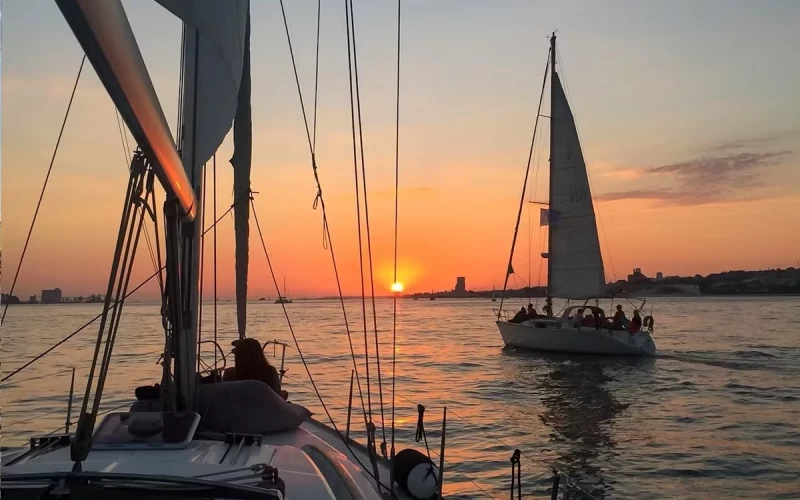
A cruise on the Tagus River in Lisbon is an excellent way to discover the city from a different perspective. Here are some tips and information to make the most of this experience:
-
Choose the Right Time of Day: Tagus River cruises offer different perspectives depending on the time of day. A sunset cruise can be particularly spectacular.
-
Opt for a Narrated Cruise: Many companies offer narrated cruises, providing historical and cultural information about the monuments and sites along the river.
-
Pre-book Tickets Online: To avoid lines at the ticket counter, consider booking your tickets online in advance.
-
Choose the Type of Cruise: There are various cruise options, from short one-hour excursions to longer cruises with meals. Choose the one that best suits your preferences.
-
Bring Sunscreen and a Hat: If you opt for a daytime cruise, especially during the summer months, it's advisable to bring sunscreen and a hat to protect yourself from the sun.
-
Enjoy Outdoor Decks: On cruise boats, outdoor decks provide the best views. Try to find a good spot to admire the landscape.
-
Have Your Camera Ready: Ensure your camera is ready to capture the beautiful views of Lisbon, the 25th of April Bridge, and other iconic sites.
-
Discover Marine Life: Keep an eye on the water, as it's not uncommon to spot dolphins in the river.
-
Avoid Peak Hours: If you prefer a quieter experience, try to avoid peak tourist hours.
-
Check Weather Conditions: Before booking, make sure to check the weather conditions, especially if you plan a cruise during the winter months when the weather can be less predictable.
By following these tips, your cruise on the Tagus River in Lisbon will be a memorable experience, offering stunning views of the city from the water.
12 - Attend a Fado Show

A Fado show in Lisbon offers a unique cultural experience, infused with melancholy, emotion, and the rich musical history of Portugal. Here's a general description of what you can expect during a Fado performance:
Intimate Atmosphere: Fado shows often take place in intimate venues, such as traditional restaurants or bars. The atmosphere is warm, creating a close connection between the artists and the audience.
Melancholic Music: Fado is characterized by melancholic melodies and poetic lyrics that often reflect saudade, a deep sense of nostalgia. Songs may evoke themes such as lost love, the sea, daily life, and Portugal's history.
Expressive Voices: Fado singers, known as fadistas, are renowned for their expressive and emotional voices. They interpret songs with passion, capturing the emotional essence of each piece.
Traditional Instrumentation: Fado instrumentation often includes the Portuguese guitar, a twelve-string guitar that produces distinctive melancholic sounds. Classical guitar and bass may also accompany performances.
Dim Lighting: Fado venues often create an intimate ambiance with dim lighting, accentuating the emotional character of the performances.
Dance and Body Expressions: While Fado is primarily a musical experience, some shows may include elements of dance or body expressions to enhance the emotion conveyed by the music.
Traditional Meals: In many places, you have the option to combine the Fado show with a traditional Portuguese meal. This adds a culinary dimension to the cultural experience.
Interaction with the Audience: Some Fado artists enjoy interacting with the audience, sharing stories or anecdotes between songs. This creates a more personal connection with the spectators.
Variety of Styles: Although Fado is often associated with melancholic ballads, there is a variety of styles, including more upbeat and joyful pieces. This provides a range of emotions throughout the performance.
Attending a Fado show in Lisbon is a deep dive into the musical soul of Portugal, allowing you to feel the history, passion, and unique beauty of this form of artistic expression.
 Our tips for getting the most out of your experience.
Our tips for getting the most out of your experience.
Attending a Fado show in Lisbon is a must for anyone looking to experience traditional Portuguese music. Here are some tips to fully enjoy this unique spectacle:
-
Choose a Good Venue: Lisbon is filled with venues offering Fado shows. Opt for a place known for its authentic atmosphere, such as the Alfama district, which is particularly associated with Fado.
-
Book in Advance: Fado shows are often in high demand, especially in popular venues. It's recommended to book your tickets in advance to ensure a stress-free experience.
-
Explore Dinner-Show Options: Many restaurants offer dinner-show packages for Fado performances. This allows you to enjoy delicious Portuguese cuisine while savoring the music.
-
Be Mindful of the Lineup: Some Fado venues feature renowned artists. If you have preferences for a specific singer, check the lineup before making a reservation.
-
Respect the Atmosphere: Fado is a melancholic and emotional music genre. During the show, respect the atmosphere by avoiding loud conversations. Immerse yourself in the music and poetic lyrics.
-
Arrive Early: To secure good seats, arrive early. This also allows you to soak in the atmosphere of the venue before the show begins.
-
Learn About the History of Fado: Before attending the show, take the time to familiarize yourself with the history of Fado. Understanding the cultural context adds an extra layer to your experience.
-
Consider Your Attire: While most Fado venues don't have a strict dress code, consider dressing decently to contribute to the appropriate atmosphere.
-
Participate but Be Respectful: Some shows encourage audience participation through applause or expressions of appreciation. However, make sure to respect the silence when necessary.
-
Appreciate the Diversity of Fado: There are different styles of Fado, from the more melancholic to the more rhythmic. Appreciate the diversity of this unique musical expression.
By following these tips, your experience at a Fado show in Lisbon will not only be enjoyable but also culturally enriching. Immerse yourself in the authentic and moving music in one of the iconic venues of the Fado scene.
13 - Taste Pastéis de Nata

Savoring Pastéis de Nata in Lisbon is an essential culinary experience. These Portuguese custard tarts are delightfully crispy on the outside and creamy on the inside. Here are some tips to fully enjoy this iconic treat:
-
Choose a Renowned Pastry Shop: Lisbon is full of pastry shops offering Pastéis de Nata. Opt for a renowned or iconic pastry shop, such as the famous Pastéis de Belém, for an authentic experience.
-
Enjoy Them Fresh and Warm: Pastéis de Nata are best when enjoyed fresh and warm, right out of the oven. Look for places where they are baked on-site for an even more delightful experience.
-
Sprinkle with Cinnamon and Sugar: Traditionally, Pastéis de Nata are sprinkled with cinnamon and powdered sugar just before being enjoyed. This adds an extra touch of flavor and fragrance.
-
Pair with Espresso or Tea: Pastéis de Nata pair perfectly with a strong espresso or tea. Order a hot beverage to accompany this sweet treat.
-
Appreciate the Experience: Take the time to sit down, savor slowly, and appreciate the experience. Pastéis de Nata are more than just a pastry; they are an integral part of Portuguese culinary culture.
-
Order a Dozen: If possible, order a dozen Pastéis de Nata to share with friends or take away with you. They are often so delicious that you'll want more than one.
-
Try Different Varieties: While the classic version is the most popular, some pastry shops offer variations, such as Pastéis de Nata dusted with cinnamon, powdered sugar, or fruit.
-
Explore Local Bakeries: In addition to tourist hotspots, explore small local bakeries in residential neighborhoods. You might discover hidden gems less frequented by tourists.
-
Take Some for Later: If you can't finish them all at once, take a few Pastéis de Nata with you. They remain delicious even after cooling.
-
Learn to Make Them: If you're passionate about baking, consider taking a local cooking class to learn how to make Pastéis de Nata yourself.
By following these tips, you'll be ready to fully savor this delicious Portuguese specialty during your visit to Lisbon. Enjoy your treat!
14 - Take a trip to Cascais
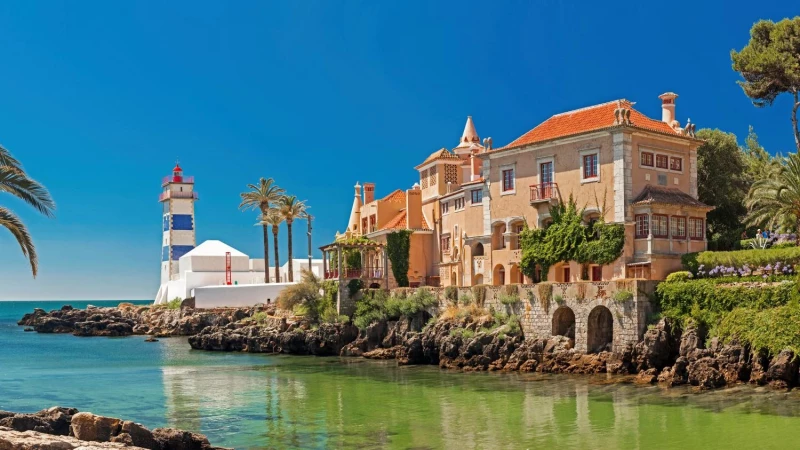
Cascais is a charming coastal town located approximately 30 kilometers west of Lisbon, Portugal. Known for its seaside ambiance, relaxed elegance, and rich historical heritage, Cascais is a favored destination for visitors. Here are some highlights and tips for exploring Cascais:
-
Historic Center of Cascais: Start your visit in the historic center of Cascais, where you can stroll through cobblestone streets, discover local shops, and enjoy charming architecture.
-
Praia da Rainha: This small beach, known as "Queen's Beach," is ideal for sunbathing and soaking in the maritime atmosphere.
-
Cascais Fortress: Explore the Cascais Fortress located on the waterfront. It provides panoramic views of the Atlantic Ocean and houses the Cascais Town Museum.
-
Cascais Marina: Cascais Marina is a pleasant place to walk along the docks, admire luxury boats, and enjoy waterfront restaurants and cafes.
-
Boca do Inferno: Just a short distance from Cascais, don't miss Boca do Inferno (the Mouth of Hell), an impressive rock formation where the waves of the Atlantic crash with force.
-
Cascais Beaches: Besides Praia da Rainha, explore other Cascais beaches such as Praia da Conceição and Praia da Duquesa, each offering a unique atmosphere.
-
Seaside Promenade: Take advantage of the seaside promenade that connects Cascais to Estoril. This pleasant waterfront walk offers stunning ocean views.
-
Condes de Castro Guimarães Museum: Discover the Condes de Castro Guimarães Museum, located in a charming palace overlooking the sea. It houses an eclectic collection of art and historical artifacts.
-
Estoril Casino: Nearby, you'll find the famous Estoril Casino, one of the largest in Europe. Even if you're not a gambler, visit this iconic building.
-
Excursions to Sintra: Cascais is an ideal starting point for excursions to Sintra, a nearby town famous for its enchanting palaces, lush gardens, and romantic atmosphere.
Cascais offers the perfect blend of coastal charm, history, and relaxation. Whether you're interested in the beach, culture, or gastronomy, this Portuguese town has something to offer every visitor.
 Our tips for getting the most out of your experience.
Our tips for getting the most out of your experience.
Taking a day trip to Cascais from Lisbon is a wonderful way to explore the picturesque Portuguese coastline. Here are some tips to make your Cascais day trip memorable:
-
Transportation: Opt for the train from Lisbon's Cais do Sodré station to Cascais. It's a scenic journey along the coast, taking approximately 40 minutes.
-
Train Ticket: Purchase your train ticket in advance to avoid queues. Tickets can be bought online or at self-service machines at the station.
-
Train Schedules: Check the train schedules in advance, especially if you have a specific itinerary. Trains run frequently throughout the day.
-
Viva Viagem Card: Use a rechargeable Viva Viagem card to pay for your train journey. This card is also valid for other public transportation in Lisbon.
-
Explore Cascais Center: Start your visit in the historic center of Cascais. Stroll through the alleys, visit local shops, and immerse yourself in the maritime atmosphere.
-
Cascais Beach: Relax on Cascais Beach, Praia da Rainha, or Praia da Conceição, and enjoy the Atlantic sun.
-
Condes de Castro Guimarães Museum: Take a tour of the Condes de Castro Guimarães Museum located in a seaside palace to discover a diverse collection of art and history.
-
Seaside Promenade: Walk along the seaside promenade connecting Cascais to Estoril. It's a pleasant stroll offering magnificent views of the ocean.
-
Boca do Inferno: Take a taxi, bus, or walk to Boca do Inferno, an impressive rock formation where the Atlantic waves crash.
-
Taste Pastéis de Nata: Don't leave Cascais without tasting Pastéis de Nata. Many local pastry shops offer these Portuguese delights.
-
Return Train Schedule: Make sure you know the return train schedules to Lisbon. Allow enough time to enjoy Cascais without feeling rushed.
-
Plan a Trip to Sintra (Optional): If time allows, consider extending your day trip to Sintra, a nearby town known for its enchanting palaces.
By following these tips, your day trip to Cascais from Lisbon will be a delightful blend of relaxation, cultural exploration, and scenic coastal landscapes.
Lisbon - Where to Stay?
1. Baixa and Rossio
Located in the historic heart of Lisbon, these neighborhoods offer a lively atmosphere, picturesque squares, and easy access to major attractions. Hotels in this area are often well-situated for exploring on foot.
2. Alfama
For an authentic experience in the narrow, winding alleys of Lisbon's oldest district, Alfama is ideal. Hotels here often provide panoramic views of the city and the river.
3. Chiado and Bairro Alto
Renowned for their vibrant nightlife, elegant shops, and trendy cafes, these neighborhoods are perfect if you enjoy lively surroundings and want to be in the midst of cultural activity.
4. Belém
For a more relaxed atmosphere and iconic tourist attractions like the Belém Tower and the Jerónimos Monastery, Belém is an excellent choice, though a bit farther from the city center.
5. Avenida da Liberdade
This tree-lined avenue, adorned with upscale shops and restaurants, is ideal if you seek sophisticated accommodation and want to be close to the city center.
6. Parque das Nações
This modern district, developed around Expo 98, is known for its contemporary architecture, the Nations' Park, and the Oceanarium. It's an interesting choice for a more modern atmosphere.
Ensure to consider your personal preferences, the purpose of your trip, and your budget when choosing the location of your accommodation in Lisbon. Whether you opt for a hotel, apartment, or hostel, Lisbon offers a diverse range of accommodation options to suit every taste.
Lisbon - How to get around?
Lisbon provides several transportation options to facilitate movement throughout the city. Here are some popular choices:
1. Tram:
Lisbon's iconic yellow trams offer a picturesque way to explore the city, especially line 28, which traverses several historic neighborhoods.2. Metro:
Lisbon's metro network is efficient for quick travel between neighborhoods. It consists of four lines that serve central and peripheral areas of the city.3. Bus:
The bus network is extensive, providing comprehensive coverage of the city and its surroundings. It's a convenient option for reaching places not directly served by the metro.4. Suburban Trains (CP):
Suburban trains operated by CP (Comboios de Portugal) are useful for traveling to the outskirts of Lisbon and exploring the surrounding areas.5. Elevators and Funiculars:
Due to Lisbon's hilly terrain, several elevators and funiculars help reach higher neighborhoods while offering spectacular panoramic views.6. Bike and Scooter Rentals:
Lisbon offers bike and electric scooter rental services, providing a flexible option to explore the city at your own pace.7. Taxis and Ride-Sharing (VTC):
Taxis and ride-sharing services (VTC) are readily available for more comfortable travel, especially when moving in groups or with luggage.8. Walking:
Lisbon is a pleasant city to explore on foot. You can wander through charming alleys, discover unexpected neighborhoods, and soak in the lively atmosphere of the city.Purchasing a rechargeable card called "Viva Viagem" allows you to use various modes of public transport with a single card. Make sure to check schedules and routes to plan your travels efficiently.
Lisbon - Best period
Lisbon is a pleasant destination to visit throughout the year due to its mild Mediterranean climate. However, your preferences for weather and tourist crowds may influence the ideal time for your visit. Here is some useful information for each season:
Spring (March to May):
- Spring in Lisbon offers mild and pleasant temperatures.
- Gardens are in full bloom, creating beautiful landscapes.
- It's an ideal time for exploring the city on foot and enjoying sunny terraces.
Summer (June to August):
- Summer is the high tourist season with sunny and warm days.
- Beaches in the region, such as Cascais and the Algarve, are popular.
- Expect a lively atmosphere in neighborhoods and local festivals.
Autumn (September to November):
- Autumn provides pleasant temperatures, slightly cooler than summer.
- It's a favorable time to avoid crowds while still enjoying sunny days.
- Grape harvesting begins in the surrounding wine regions.
Winter (December to February):
- Winters in Lisbon are mild, but with cooler temperatures and occasional showers.
- Christmas decorations add a festive atmosphere to the city.
- It's a quieter tourist period, potentially offering more affordable accommodation rates.
In summary, the ideal time to visit Lisbon depends on your preferences for climate and activities. Spring and autumn are often considered optimal seasons, providing a balance between pleasant weather conditions and more moderate tourism levels.
